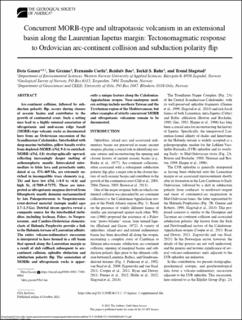| dc.contributor.author | Gasser, Deta | |
| dc.contributor.author | Grenne, Tor | |
| dc.contributor.author | Corfu, Fernando | |
| dc.contributor.author | Bøe, Reidulv | |
| dc.contributor.author | Røhr, Torkil Sørlie | |
| dc.contributor.author | Slagstad, Trond | |
| dc.date.accessioned | 2022-02-21T10:52:29Z | |
| dc.date.available | 2022-02-21T10:52:29Z | |
| dc.date.created | 2021-09-12T13:44:47Z | |
| dc.date.issued | 2021 | |
| dc.identifier.citation | Gasser, D., Grenne, T., Corfu, F., Bøe, R., Røhr, T. S., & Slagstad, T. (2021). Concurrent MORB-type and ultrapotassic volcanism in an extensional basin along the Laurentian Iapetus margin: Tectonomagmatic response to Ordovician arc-continent collision and subduction polarity flip. GSA Bulletin. | en_US |
| dc.identifier.issn | 0016-7606 | |
| dc.identifier.uri | https://hdl.handle.net/11250/2980449 | |
| dc.description.abstract | Arc-continent collision, followed by subduction polarity flip, occurs during closure of oceanic basins and contributes to the growth of continental crust. Such a setting may lead to a highly unusual association of ultrapotassic and mid-ocean ridge basalt (MORB)-type volcanic rocks as documented here from an Ordovician succession of the Scandinavian Caledonides. Interbedded with deep-marine turbidites, pillow basalts evolve from depleted-MORB (εNdt 9.4) to enriched-MORB (εNdt 4.8) stratigraphically upward, reflecting increasingly deeper melting of asthenospheric mantle. Intercalated intermediate to felsic lava and pyroclastic units, dated at ca. 474−469 Ma, are extremely enriched in incompatible trace elements (e.g., Th) and have low εNdt (−8.0 to −6.6) and high Sri (0.7089−0.7175). These are interpreted as ultrapotassic magmas derived from lithospheric mantle domains metasomatized by late Paleoproterozoic to Neoproterozoic crust-derived material (isotopic model ages 1.7−1.3 Ga). Detrital zircon spectra reveal a composite source for the interbedded turbidites, including Archean, Paleo-, to Neoproterozoic, and Cambro-Ordovician elements; clasts of Hølonda Porphyrite provide a link to the Hølonda terrane of Laurentian affinity. The entire volcano-sedimentary succession is interpreted to have formed in a rift basin that opened along the Laurentian margin as a result of slab rollback subsequent to arc-continent collision, ophiolite obduction and subduction polarity flip. The association of MORBs and ultrapotassic rocks is apparently a unique feature along the Caledonian-Appalachian orogen. Near-analogous modern settings include northern Taiwan and the Tyrrhenian region of the Mediterranean, but other examples of strictly concurrent MORB and ultrapotassic volcanism remain to be documented. | en_US |
| dc.language.iso | eng | en_US |
| dc.publisher | Geological Society of America | en_US |
| dc.rights | Navngivelse 4.0 Internasjonal | * |
| dc.rights.uri | http://creativecommons.org/licenses/by/4.0/deed.no | * |
| dc.title | Concurrent MORB-type and ultrapotassic volcanism in an extensional basin along the Laurentian Iapetus margin: Tectonomagmatic response to Ordovician arc-continent collision and subduction polarity flip | en_US |
| dc.type | Peer reviewed | en_US |
| dc.type | Journal article | en_US |
| dc.description.version | publishedVersion | en_US |
| dc.rights.holder | © 2021 The Authors. | en_US |
| dc.source.pagenumber | 25 | en_US |
| dc.source.journal | Geological Society of America Bulletin | en_US |
| dc.identifier.doi | 10.1130/B36113.1 | |
| dc.identifier.cristin | 1933522 | |
| cristin.ispublished | true | |
| cristin.fulltext | original | |
| cristin.qualitycode | 2 | |

